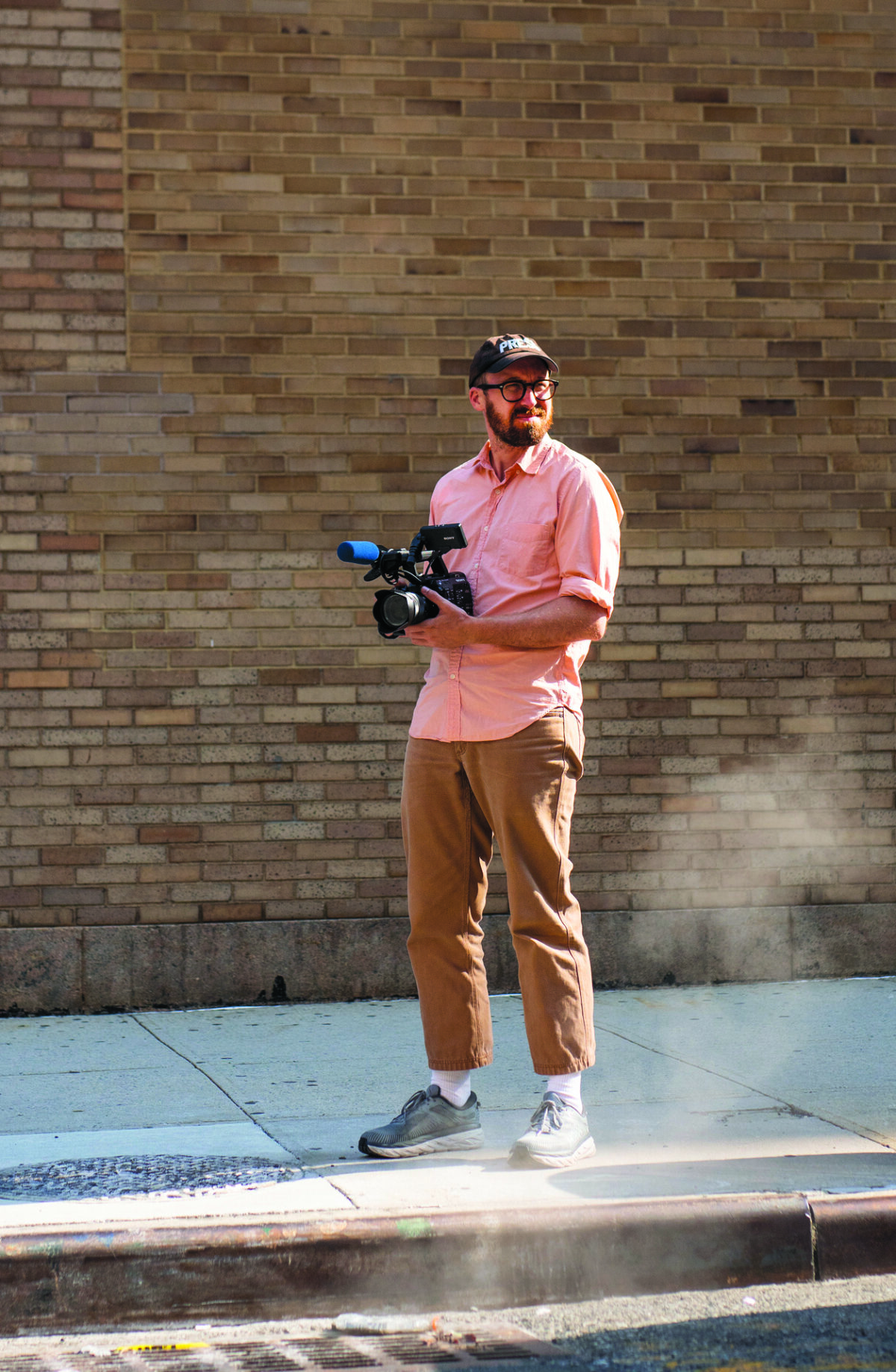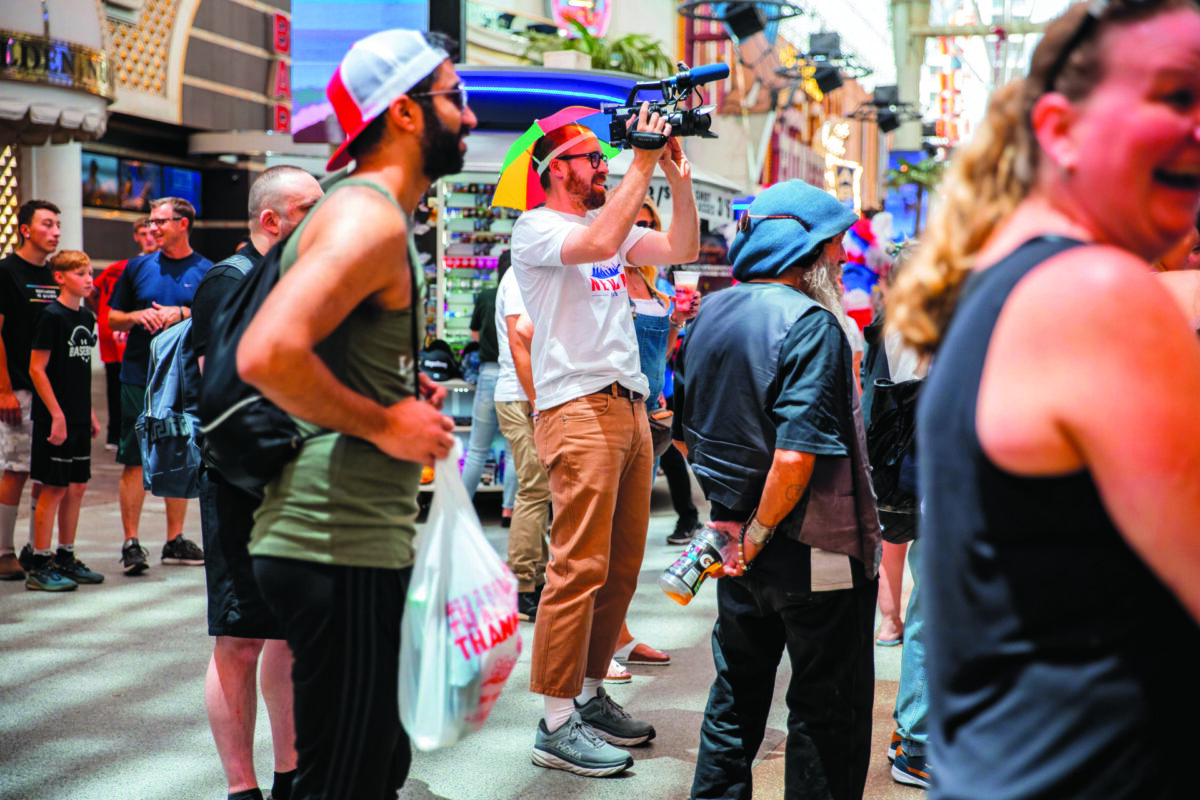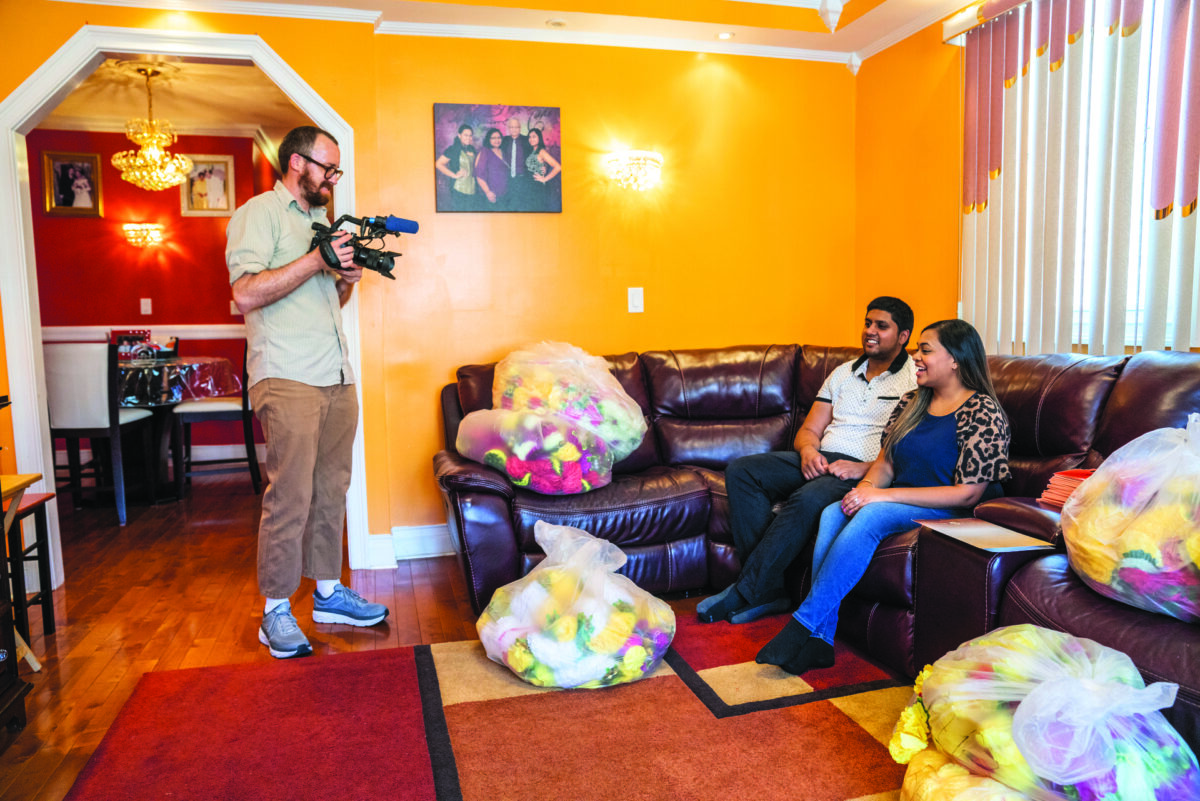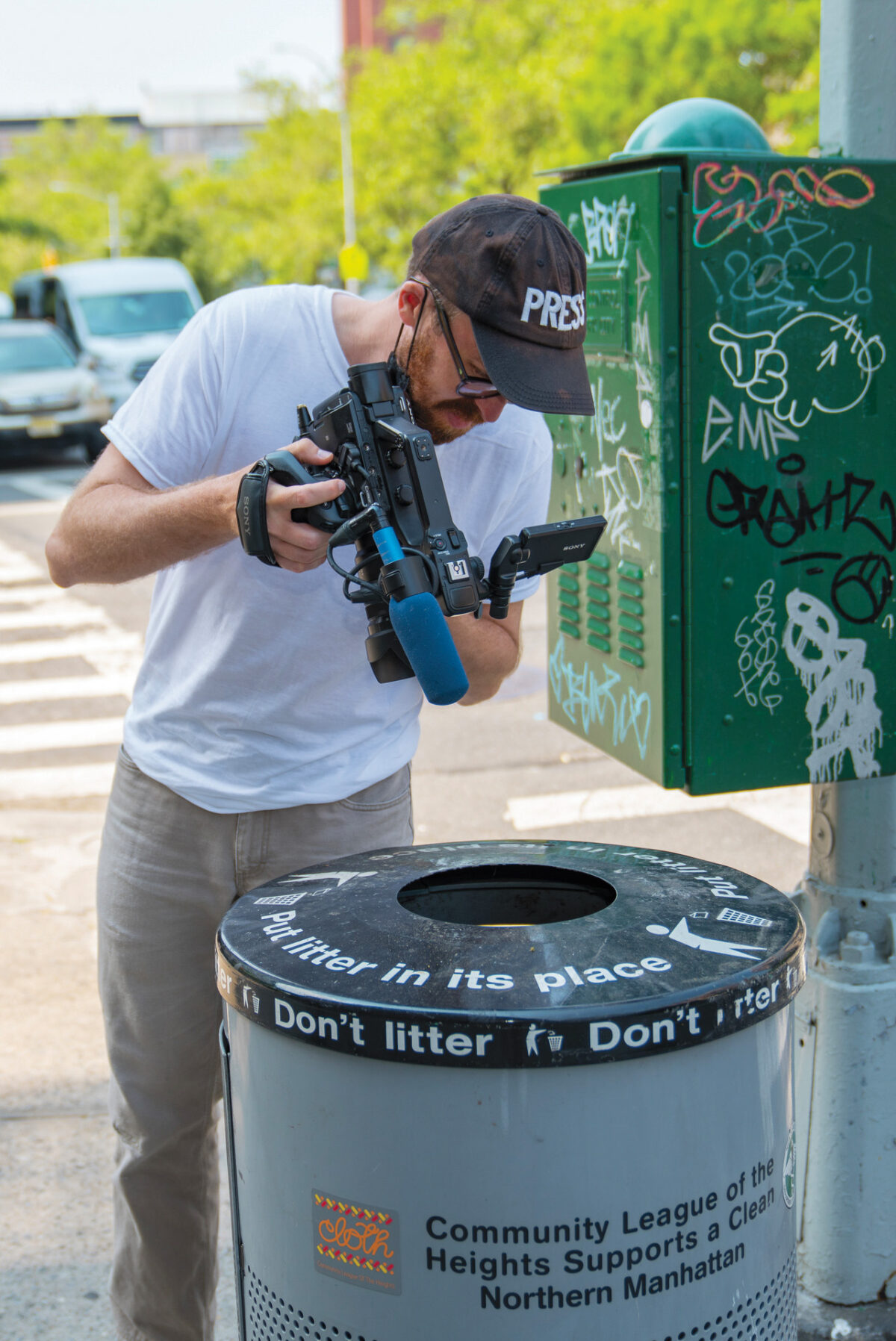1.
John Wilson’s HBO docu-comedy series, How To with John Wilson, is multi-layered, to put it mildly. In the guise of an instructional video, the show combines hyper-curated scenes of only–in–New York City strangeness, Wilson’s deftly edited interviews with everyday weirdos he doesn’t name, and his uniquely staccato second-person narration, to create brilliant and funny visual essays that have earned him a devoted following and critical acclaim.
The show has aired for two seasons; its highly anticipated third and final season will premiere on July 28. Its writers’ room boasts a startling array of talent: best-selling author Susan Orlean, Orlean’s fellow New Yorker scribe Alice Gregory, Nathan for You alum Michael Koman, and the gloriously unhinged comedian Conner O’Malley.
Wilson is remarkably reticent as the host of his own TV show. He’s almost never on camera, and when he is, it’s only in footage from the past, or when his hand, or maybe his shoe, appears in the frame as he films. Despite this stance, he has managed to make some singularly personal work. Part of the attraction of the series is the sense that, over two seasons, he is slowly letting viewers get to know him better.
That he is clearly more comfortable behind the camera is part of his appeal. In the season one episode “How To Cover Your Furniture,” Wilson speaks with an interior decorator about a furniture dilemma he’s having. She responds to him—strangely, given the context—like a psychic. Studying him carefully, she makes the observation that he is “always used to having some kind of protective mechanism.” She then offers him this piece of advice: “I would love for you, sometimes in your life, in your head, to be like, I should put the camera down in this situation. I should just be John.”
2.
Wilson is most definitely carrying his camera when I meet him in front of the GameStop in Herald Square. He’s hard to miss, in that he’s six-foot-two and wearing the khaki hat and jacket I recall from promo images for the show. He’s visible in his role as an unassuming documentarian.
I thought he asked to meet outside the GameStop because he wanted to shoot something there, but no. “They don’t like it when you film,” he says. He’s already been thrown out once.
Wilson is looking for particular items today. He pulls out a tiny notebook. I can see words written in the distinctive shaky hand I recognize from the How To titles, which Wilson paints himself, using HBO-supplied Wite-Out. The top two items are pictures of women in bikinis, the kind you might find on the wall inside an auto body shop, and clear bottles of piss, often made surreptitiously by bathroom-deprived motorists, who fill them and then fling them out their car windows.
I mention the parallel between this quest and the augmented-reality mobile game Pokémon Go, which a few people have been playing in the cold outside the GameStop entrance. Wilson nods, then adds that he hopes that, unlike in Pokémon Go, “there is no great programmer dictating what I see.”
3.
Wilson is thirty-six. At one point during his childhood in Rocky Point, Long Island, he made a movie a day. To say he was devoted to filmmaking is an understatement. He would miss a family vacation in order to finish a movie.
Wilson filmed his creations on a Sony Handycam, which was a gift from Wilson’s mother to his father on his father’s fortieth birthday. The younger Wilson quickly commandeered the camera. He has remained brand loyal: Wilson now shoots on a Sony FS5, a nice upgrade.
Wilson’s early movies belie his later stance as a reluctant performer. They consist primarily of parodies featuring himself, with his name worked into every title, e.g., RoboJohn and John Wars. He made these films with friends, including Chris Maggio, who now works on How To as a camera person.

Maggio was Wilson’s partner on Jingle Berry, a film they made together at the end of high school, which is highlighted in the season 2 episode “How To Throw Out Your Batteries.” Wilson speaks highly of his longtime collaborator, saying, “He shoots the most like me, but also I think he’s better than me in a lot of ways, in terms of finding interesting ways to compose images of things you wouldn’t think to shoot.”
Wilson was also involved in theater when he was younger, playing the lead, Joe Hardy, in his high school’s production of the musical Damn Yankees. And he was a huge fan of comedian Chris Farley, even going so far as to choose the name Farley as his communion name. He was told he couldn’t use it, however, because Farley had just died from a drug overdose.
Wilson mostly avoids theater people in the work he does now, noting that he wants to stay as far from artifice as possible. Also, he is no longer a practicing Catholic.
4.
Wilson spent his earliest years in Astoria, Queens, before his father, who had been working in Manhattan as a systems analyst for MetLife, was transferred to Hauppauge, Long Island, and the family relocated to Rocky Point. His mother worked as an educator and then as an administrator in the Rocky Point public schools, which John and his younger brother, Tom, both attended.
His father has great taste in art, Wilson says, recounting how his dad used to take him and his brother to MoMA PS1. When his dad got a DVD player, the first movie he bought, from the used-DVD section at Blockbuster, was Jim Jarmusch’s Stranger Than Paradise.
His parents are supportive of his work, “but they hold their breath with each episode,” Wilson says. He mentions that he tries not to include people he knows in the show to such a degree that it would “ruin my life.”
Still, each episode of How To includes a memoir component, and the finale of season 2, “How To Be Spontaneous,” is arguably one of the most intimate Wilson has thus far made. About a third of the way into it, over anonymous images of people and objects in the city, Wilson unspools the following narration, revealing how some family history is entwined with his approach to documentary:
When you were growing up, your dad would always try to bring you to places, but they would always turn out to be closed when you got there. This happened so often that he eventually started a blog called Closed Places, where he started posting photos of each incident as a way to deal with the pain.
This kind of scared you from making plans, because they never seemed to work out very well. So you just stumbled through life like a piece of driftwood, letting the world shape you instead of trying to control anything. Almost every single thing you’ve ever recorded is the direct result of randomly being in the right place at the right time, and it terrifies you to think that you could have missed out on all this great stuff if you had made plans to begin with.
But doing things impulsively doesn’t always work out the way you hoped it would, either. Maybe your trip to get a massage was disappointing because you expected it to work out a certain way. And the only way around the family curse is to become a truly spontaneous being and remove anything that even resembles a plan from the equation.
The narration lands on the image of a dead pigeon.
5.
In one way, at least, Wilson has always had a plan: to be a great filmmaker. After graduating from high school, he went to SUNY Binghamton to study film. (His buddy Maggio went to Boston University, “the real BU,” he quips.)
Binghamton’s cinema department has a strong history of experimental filmmaking. By the time Wilson got there, he had moved on from making parodies and begun work on original narratives. At Binghamton, he began taking some creative risks. A pivotal moment came when he turned in a short documentary about balloon fetishists, titled Looner. “After that, I was hooked,” he says.
Wilson did make another scripted film with Maggio after college, when the two reunited and were living in Cambridge, Massachusetts. The movie they wrote, People Parade, has some foreshadowing of How To’s primary concerns: it’s about a low-budget variety show in which Wilson plays the son of the recently deceased host. Filling in for his dad one evening, Wilson introduces a series of increasingly screwball acts while managing several behind-the-scenes disasters.
People Parade is funny, but it wasn’t fun to make. “It was so stressful for me,” Wilson says, “that I decided I didn’t really want to do [narrative films] anymore. I never wanted to ask someone to do anything again when I couldn’t pay them.”

As he was deciding to give up narrative filmmaking, however, his real life was hewing closer to an episode of How To. In Cambridge, he had embarked on a job working for a private investigator. His daily commute involved riding his bike to the Red Line; taking the Red Line to South Station; taking the commuter rail to Hanson, Massachusetts; and finally proceeding on foot to a building he describes as a “weird two-story boxy office building in the back of a pizzeria parking lot.”
Once there, Wilson climbed up to the second floor, where he sat at a small desk next to his boss’s office. Wilson scrubbed footage he had been given, looking for any incriminating moments. He would then export that footage for his boss, who in turn sent it to his clients.
The clients were mostly lawyers focused on issues of workers’ comp, so the type of footage Wilson was watching was shot by people who were, for example, wearing hidden cameras into Home Depot, filming someone who should have been in a wheelchair, carrying a two-by-four. “It definitely informed the way that I shoot,” he says. “It felt really exciting even though the stuff was really boring.”
After finishing his work early in the day, Wilson spent the rest of his time on the clock watching movies. “I realized that there was a mountain of stuff I needed to watch to become the filmmaker that I wanted to become. So I just spent hours every day watching all the ’60s, ’70s [films]—like Godard and Cassavetes, just doing the whole chronology, figuring out what I liked and what I didn’t like.” When not watching films, he took occasional breaks to do push-ups in the bathroom. “I had no future,” he says. “All I knew was that I had time.”
Wilson was positioned at his desk in such a way that his boss couldn’t see what he was doing. “But,” Wilson adds wryly, “I feel like they probably had an idea, which is why they eventually fired me and replaced me with a high schooler that they didn’t pay.”
Some of Wilson’s other activities during this time also required him to fine-tune some covert abilities. He remembers pinching copies of this very magazine from a Cambridge newsstand. And he and some friends, occasionally including Maggio, routinely snuck into the Harvard dining halls for free meals.
“There’s a special door at Adams House where the ID checker can’t see you,” he says. “But the students eventually were like, ‘Who are these kids? We don’t see them in class.’ But we became friends with them, and they’d invite us to stuff.”
6.
Roaming the West Side of Manhattan in the cold, Wilson is looking for his pee bottle Snorlax. He said he’s open to suggestions for things to shoot, so I point out a funny-looking tree, but he passes. Later, I show him a doorway where an unfortunate New Yorker appears to have vomited a box of Lucky Charms. He shoots it, noting dryly, “I’m always looking for texture.”
We walk farther, and then suddenly Wilson stops in the middle of Forty-First Street, on the west side of Ninth Avenue. I initially don’t understand what he’s doing, as he stands, back and knees bent, blocking traffic.
But then I see it: the evidence not of the great programmer, but of the Great Programmer. It’s a bottle of piss, unmistakably yellow in its repurposed Poland Spring bottle—a little unsung hunk of gold, sitting quietly at the edge of the curb.
7.
When Wilson left Cambridge and moved to New York, he began looking for work by searching online for film schools in the city, and New York Film Academy was one of the top hits. Wilson “applied” for a job there using an unusual method: after scouring the web for the name of a department head, Wilson put on some business attire and strode into the NYFA offices, then in Union Square.
He told the receptionist that he had a 2:00 p.m. meeting with the department head, and she called up to see if he was ready. He said he was in a meeting but would see Wilson in fifteen minutes.
“And then I go up,” says Wilson. “I think he thinks he forgot about this meeting. And then he asked me what I’d like to do. And I was like, ‘Well, I’m really good at editing. I think I’d be a wonderful editing teacher.’ And he’s like, ‘Great. We just let go of our broadcast journalism editing person.’” Wilson took the job.
I express astonishment at how well this scheme unfolded, and Wilson confesses, “I had tried to fake something on a résumé once before and it didn’t go well… but this time, it worked.” He goes on to acknowledge, “There is this kind of like ‘What can you get away with?’ mentality that I’ve had, I think, for a lot of my life.”
Wilson stayed at NYFA for about a year before leaving to work as a cameraman shooting informercials, among other things, at a media company on West Thirty-Sixth Street. In the episode titled “How To Put Up Scaffolding,” he characterizes his work there as “helping to create some of the most grotesque content on the planet.” He took the job initially thinking he would stay there for only one day. Five years later, he was still there.

Frustration with work might ultimately have been the force that helped Wilson make the film that would bring him to the attention of Nathan Fielder, the comedian and star of HBO’s The Rehearsal, who is now How To’s executive producer.
The impetus for Wilson’s life-changing film was a work problem: he had taken a freelance gig making a fashion video, but after a long day of filming and two months of edits, the LA-based client decided that Wilson’s film was “unpresentable,” and never paid him. When the client stopped returning his calls and then disconnected his number, Wilson took matters into his own hands, bringing the problem to the ultimate arbiter: court TV.
Wilson pitched the case to one court TV show, whose producers informed him that nothing could happen if the defendant refused to cooperate. So Wilson decided to pitch the show again, this time without relying on his former client. Instead, he would dramatize the story, reenacting it with close friends.
Wilson got his friend Clark Filio (now a producer on How To) to agree to play the client. He then began contacting more court TV shows, and at last he heard from an LA-based show called Hot Bench (“From the producers of Judge Judy”!). They asked to see the fashion video in question, so Wilson and Filio dressed up their friend Sharif El Neklawy in “some stylish clothing,” and in a few hours, they had put together a (highly amusing) fashion video.
Hot Bench took their case. The show booked the “adversaries” on separate flights to LA and in miles-apart hotel rooms. Their appearance is hilarious, in part because Wilson is straining heroically to keep his upper body still. We know why: his conservative-looking tie contains a hidden camera.
The proceedings are revealed in cuts between the polished show as it was aired to TV viewers and the grainy, haphazard footage as recorded via Wilson’s tie. After the judges rule in Wilson’s favor, and Wilson and Filio trade (wonderfully faked), bitter post-decision barbs, we finally see Wilson, Filio, and El Neklawy meeting up at a Steak ‘n Shake in Santa Monica to celebrate.
But the slightly-less-than-twenty-minute film aims to do more than record a prank. Titled Los Angeles Plays New York, it is a riff on Los Angeles Plays Itself, a 2003 video essay by Thom Andersen which is constructed entirely of clips from other movies, and which explores the way Los Angeles has been portrayed on-screen.
In Los Angeles Plays New York, Wilson observes that despite Hot Bench being made in LA, its set and intro were shot in New York City. Musing on this, he notes that “one day we may all realize that the real New York has become too unrealistic.” It’s a nice foreshadowing of how he will eventually approach what is How To’s ultimate subject: the completely real unreality of New York City.
After Fielder had a chance meeting with Filio, whom he recognized from Los Angeles Plays New York, Fielder and Wilson were connected, and the two began to collaborate. Speaking to The New York Times, Fielder characterized his role with the show as “trying to help out with whatever.” Wilson acknowledges that the two of them have had some heated creative disagreements, but he also notes with gratitude that Fielder “definitely talked me off the ledge a few times.”
Los Angeles Plays New York was screened at the 2016 New York Film Festival, after which Wilson received a cease and desist order from the fashion client. The film, sadly, is viewable now only if Wilson gives you the Vimeo password.
8.
The way How To is crafted is highly unusual, in that the script follows the images, not vice versa. Further complicating matters is the fact that most of the images aren’t even collected until after the writers’ room work is complete.
“When you look back at the script after the episode is finished, it’s unrecognizable,” Wilson says. “Everything needs to be rewritten.”
The process goes like this: Wilson comes to the writers’ room with seven or eight potential titles for a six-episode season. The writers then generate the material that could be contained under the umbrella of each title, eventually developing a script for each.
The scripts then dictate what the camera people will shoot. At this point, Wilson begins principal photography and records interviews and B-roll every day. At night he “power-scans,” as he puts it, through hours of footage that the four separate B-unit teams have shot, which sounds like a gargantuan task. But Wilson sees it differently, characterizing it as “a dream come true. It’s like I go out and shoot all day on my own, and then I get this massive dump of some of the funniest, coolest footage in the world. And I get to zone out on my computer and just make selects.”
While the assistant editors do the meticulous tagging and key-wording of each shot—which are then put into themed sequences—Wilson’s personal project file is much less organized. He usually works from a master sequence that contains every single select of B-roll he has made since the beginning of the show. He refrains from ordering it, because he thinks that’s the most inspiring way to look at it: “If I’m having writer’s block within the edit, I’ll just, like, go in and say, Okay, let me find something that’s really funny that I haven’t found a home for yet. And then, you know, it has a nice way of, like, jogging your creativity.”
As the camera people are shooting, Wilson begins to notice patterns of shots that weren’t necessarily called for in the scripts. Once there’s two of something, he’ll ask the teams to go get twenty more. Sometimes it doesn’t turn into anything, but “it’s really important to fill out these kind of transitional moments within the episode, because I want the imagery to be really rich, first and foremost.”
Given this method, is the writers’ room in some ways perfunctory? “I think you ultimately need it,” he says. “[Michael] Koman and I put a lot of thought into whether or not a concept is strong enough to carry an episode, and you need to do the writing, even if the script is ludicrous. You need to see if it could be a container for enough funny ideas.”
He brings up the example of the episode “How To Appreciate Wine,” which started out as “How To Have Taste,” before it was decided that the concept needed to be narrowed. “If you start too high off the ground,” he says, “it’s like there’s nowhere else to go.”
9.
THE BELIEVER: In every episode, you’re relying on the universe to present you with some unbelievable imagery. What is your secret to unlocking that? Are you praying?
JOHN WILSON: I don’t pray. I just—I believe in, I don’t know, the kind of benevolent chaos of the universe that, that just, like, rewards people that just… try a bunch of stuff.
BLVR: [Laughs]

JW: I’m trying to think of, like, how to define this. I think the key is just letting people talk, you know, and just continuing to ask questions. Asking questions is just the best way to deal with social anxiety. It’s the best way to make documentaries for me. I love Huell Howser’s interview style. Do you know him? He is a local California TV personality who would just walk into a restaurant with a microphone and just start asking people what was going on. And he was just, like, so eternally stoked about everything he saw. I love that energy.
BLVR: You said earlier that when you think about how easily you might have missed a particular incredible shot, it’s scary. Why is that scary?
JW: Just because, like, I’m just so in love with the thing itself. It would be like thinking about if you never met your partner, you know? It’s like that kind of dread.
I try not to think about it that way as much anymore, because it’s all just a product of trying. I regret a lot of stuff, but the one thing I never regret is going out to shoot. I know I will come back with something that I just wouldn’t have had otherwise. I just try to maximize the opportunities for that once-in-a-lifetime, you know, shot.
10.
In Janet Malcolm’s book The Journalist and the Murderer, there is a line that is reminiscent of the way Wilson’s interviewees come across on his show: “People tell journalists their stories as characters in dreams deliver their elliptical messages: without warning, without context, without concern for how odd they will sound when the dreamer awakens and repeats them.”
Wilson is in our apartment, petting our family dog, who is also my Pikachu. I ask Wilson if there is anything else he wants to tell the very intelligent readers of this magazine. He considers this for a few seconds, then says. “Uh, there’s a hidden joke inside everything. And if you’re ever bored, if you stare at something for long enough, you’ll find it.”
“That’s interesting. Do you meditate?”
“No. I should.”
“You were raised Catholic,” I reiterate.
“Yes, but I didn’t learn anything from that,” he says.
I mention that staring at something long enough to find the joke hidden within it is a different type of practice.
“Yeah,” he says finally. “This kind of work is my religion, I think.”




